Book by Bruno Cousin

Seuil, 2017
Les pauvres suscitent-ils aujourd’hui, chez les riches, une répulsion similaire à celle que le pe... more Les pauvres suscitent-ils aujourd’hui, chez les riches, une répulsion similaire à celle que le peuple inspirait aux bourgeois au xixe siècle ? Autrement dit, les démunis sont-ils encore considérés comme une classe dangereuse, immorale et répugnante ? En interrogeant le refus de la mixité résidentielle manifesté par les catégories supérieures, telle est la question frontale que pose cet ouvrage, issu d’une grande enquête comparative sur les perceptions de la pauvreté et des inégalités dans les beaux quartiers de trois métropoles : Paris, São Paulo et Delhi. À partir d’entretiens approfondis, il montre que la quête d’entre-soi des habitants des ghettos dorés n’est pas seulement motivée par une recherche de prestige et de qualité de vie, mais également par des représentations des pauvres qui les incitent à s’en protéger. Comment parviennent-ils à justifier leurs stratégies d’évitement et de relégation des catégories défavorisées, ainsi qu’à légitimer l’ordre local qu’ils s’efforcent de perpétuer ? Au-delà de la peur de la criminalité et de l’insalubrité apparaît la crainte des élites d’être en quelque sorte contaminées par des modes de vie jugés culturellement indésirables ou moralement nuisibles. À travers les mécanismes du séparatisme social, ce sont les conditions de possibilité de la solidarité que cet essai explore.
Edited books by Bruno Cousin

La Découverte, 2019
Avec des contributions d'Adalberto Cardoso, Anaïs Collet, François Cusin, Patrick Le Galès, Sonia... more Avec des contributions d'Adalberto Cardoso, Anaïs Collet, François Cusin, Patrick Le Galès, Sonia Lehman-Frisch, Dominique Lorrain, Isabelle Mallon, Élise Palomares, Gilles Pinson, Edmond Préteceille, Sylvie Tissot, Christian Topalov, Simone Tosi, Damien Vanneste, Stéphanie Vermeersch, Tommaso Vitale et Loïc Wacquant.
Face à l’urbanisation croissante de la planète et à la mondialisation qui donnent parfois l’impression d’une homogénéité globale, la comparaison internationale entre villes est devenue un enjeu majeur. Nombre d’organisations publiques et privées classent ainsi les métropoles selon des critères standardisés. Dans le champ académique, la circulation transnationale et les injonctions à l’internationalisation des recherches nourrissent les démarches comparatistes. Mais pourquoi et comment comparer ? Quels sont les avantages, les difficultés, les limites et les pièges de la comparaison ?
Cet ouvrage réunit une vingtaine de chercheurs en sociologie urbaine, qui pratiquent dans leurs travaux la comparaison internationale. Leurs contributions illustrent en quoi, et à quelles conditions, la comparaison peut permettre de mieux analyser les structures socio-spatiales, les processus, les normes et les catégories de pensée. Elles montrent aussi, au-delà de l’approche monographique souvent adoptée dans l’étude des villes, ou en complément de celle-ci, comment différentes façons de comparer permettent de monter en généralité et de développer l’inventivité théorique.

Routledge, 2018
With chapters by Matthew L. Bishop, J. A. Roy Bodden, Audrey Célestine, Peter Clegg, Gérard Collo... more With chapters by Matthew L. Bishop, J. A. Roy Bodden, Audrey Célestine, Peter Clegg, Gérard Collomb, Justin Daniel, Lammert de Jong, May Hen, Edenz Maurice, Guy Numa, Genève Phillip, Chelsea Schields, Ron van der Veer, Wouter Veenendaal and William Vlcek.
This edited collection examines the realities of the last remnants of the European colonial empires in the Caribbean, namely the British, Dutch and French overseas territories.
Although known and perhaps infamous for their role as high-end tourist destinations and financial centres, these small jurisdictions are complex and multifaceted places. While this volume considers their role as financial centres, it does so from alternative and original perspectives by examining how the sector shapes the internal dynamics of these Caribbean societies, and how it is itself shaped by global trends. A range of contributions is included that highlight other key issues. Political relations between the territories and their metropolitan centres and with the European Union are the focus of several chapters, highlighting the stresses and strains, and in many cases the unfulfilled expectations of devolved governance. Further chapters describe the economic instability and factors of political conflict faced by some of these societies and the available options to address them. Finally, several chapters reflect more specifically on the territories’ internal social and ethnic dynamics, and the hierarchies and inequalities that result.
Bringing together a variety of different disciplinary perspectives, from political science to sociology, and from anthropology to geography, this book will be of great interest to any academic or student who wishes to see how an often overlooked part of the world is actually a key site of socio-economic transformation and a crucial nexus in global affairs.
Edited special issues by Bruno Cousin
Peer-reviewed articles by Bruno Cousin
British Journal of Sociology, 2025
The strategies, decisions and beliefs of those who occupy prominent positions of economic power h... more The strategies, decisions and beliefs of those who occupy prominent positions of economic power have influence on very large corporations and the markets they dominate, on vast amounts of economic resources, and on the rules of the game. However, the sociology of elites faces a dual challenge: divergent conceptualisations of what can be considered as a position of economic power and internationally incompatible sources of information hinder comparative analysis. The World Elite Database (WED) addresses this dual challenge, by generating, based on a consistent definition, standardised data for 16 countries. This research note introduces WED, its construction principles, and presents preliminary findings on how economic elites differ across countries.
Sociology Compass, 2021
In recent decades, accelerating processes of globalization and an increase in economic inequality... more In recent decades, accelerating processes of globalization and an increase in economic inequality in most of the world's countries have raised the question of the emergence of a new bourgeoisie integrated at the global level, sometimes described as a global super-bourgeoisie. This group would be distinguished by its unequaled level of wealth and global interconnectedness, its transnational ubiquity and concentration in the planet's major global cities, its specific culture, consumption habits, sites of sociability and shared references, and even by class consciousness and capacity to act collectively. This article successively discusses how the social sciences have examined these various dimensions of the question and begun to provide systematic empirical answers.

Socio-Economic Review, 2018
In this introductory essay to our special issue on elites, we outline some of the major challenge... more In this introductory essay to our special issue on elites, we outline some of the major challenges to research in this area and propose a series of theoretical and methodological pathways to address them. Theoretically we make four recommendations: (a) greater attentiveness to and specificity about the relationship between elites and power; (b) a clearer articulation of the relationships between elites and the varieties of capitalism; (c) far more attention to diversity within elites and the use of elites to understand forms of domination like white supremacy and masculine domination and (d) expanding beyond the orthodox form of Bourdieusian theoretical frameworks. Methodologically we outline how research using survey instruments, social network analysis (SNA) (and multiple correspondence analysis), interviews, ethnographic observation, experiments, archival research, administrative data and content analysis can each be deployed, built upon or redirected to help bring elites into greater focus.
Dialogues in Urban Research, 2024
Comments on Bas van Heur's bibliometric article about urban studies as a global field of research... more Comments on Bas van Heur's bibliometric article about urban studies as a global field of research, and how to improve their inclusivity and decentralization.

Journal of Urban Affairs, 2023
After the 2018 general election, several scholars remarked on the failure of the 5 Star Movement ... more After the 2018 general election, several scholars remarked on the failure of the 5 Star Movement (5SM) to increase its vote in Milan. While the role of demographic and socioeconomic factors has been highlighted, little attention has been devoted to spatial dynamics. The authors analyze the greater city of Milan using a new set of spatial units that capture the characteristics of the local populations which voted at specific polling stations. They regress support for the 5SM in each electoral district on a range of demographic, socioeconomic and spatial variables. The results show that more disadvantaged districts just outside the municipality have a strong propensity to support the 5SM. Many of the individuals and families living in these areas were negatively affected by economic crisis and continue to experience strain. These are not places of extreme marginality but have unsatisfied needs that are largely ignored by the traditional parties.

Meridiana, 2019
In the aftermath of the 2018 general election results, several scholars have remarked on the inab... more In the aftermath of the 2018 general election results, several scholars have remarked on the inability of the Five Star Movement to increase its vote in Milan. While the role of demographic and socio-economic factors has been highlighted, little attention has been dedicated to understanding the complex role of spatial dynamics. This paper aims to contribute to the existing literature by inquiring about the relationship between support for the Five Star Movement and the characteristics of urban space in Milan. Following the longstanding debate in urban sociology, we recognize the importance of investigating this question beyond the borders of the central municipality. We overcome the problematic nature of standard approaches by analyzing the entire functional urban area of Milan as defined by OECD, using a new set of areas. Adopting an ecological approach, we define our spatial units in such a way that they have a sociological meaning and embrace the characteristics of the local population which actually voted at a specific polling station. We regress support for the Five Star Movement in each electoral district on a range of demographic, socio-economic and spatial variables. The results show that more disadvantaged districts beyond Milan’s municipal borders have a strong propensity towards supporting the Five Star Movement. Many of these areas were negatively affected by the economic crisis of 2008 and continue to experience severe difficulties. They are not places of extreme marginality, but may be described as «disenfranchised» areas with many unsatisfied needs that are largely ignored by the traditional parties.
Actes de la recherche en sciences sociales, 2019
Actes de la recherche en sciences sociales, 2019

Actes de la recherche en sciences sociales, 2019
This article is based on the study of two private teachers catering to billionaires and multi-mil... more This article is based on the study of two private teachers catering to billionaires and multi-millionaire clients. It analyzes the work of physical education specialists whose key role for contemporary high-bourgeoisie households includes helping organize their sociability and ensuring the intergenerational transmission of dispositions valued among economic elites. The first section offers a detailed description of the activities and employment conditions of Nathalie (a yoga professor and massage therapist) and Benjamin (a tennis coach). In the second section, we study their trajectories and highlight the early socialization to upperclass culture that made them possible. The third section examines the strategies they deploy – including their multi-territoriality – in order to select and renew their clientele. The concluding section focuses on the complexity of the interpersonal relations they maintain with their clients/students, which combine professional and field-specific authority with the lexicon of friendship.

Actes de la recherche en sciences sociales, 2019
This conversation with Dominique Memmi revisits the heuristic value of her concept of “close domi... more This conversation with Dominique Memmi revisits the heuristic value of her concept of “close domination” (domination rapprochée). This concept refers to a relation of durable co-presence within a confined space and underlines the physical dimension of relations between the dominant and the dominated. Does it retain its relevance to account for the recent transformations of the relationships with domestic workers? Dominique Memmi recalls the gain that came along with the possibility to not have anymore to reside at their employers’ home – an advantage that has had its setbacks, in the form of new types of intolerances, starting with the ones towards invisibilisation and the confrontation to bodily manifestations (noise, smells, waste). In a context of growing inequality, in which the benefits of a certain social prestige are enjoyed only by a small minority of domestic workers at the service of the very wealthy, how is this condition generally experienced and accepted?
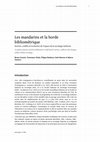
Socio-Logos, 2022
L’article présente les équilibres, oppositions et conflits des dernières décennies qui ont contri... more L’article présente les équilibres, oppositions et conflits des dernières décennies qui ont contribué à la réorganisation institutionnelle de la sociologie italienne, ainsi qu’à l’évolution de ses pratiques de recrutement, d’évaluation et d’avancement. Ces changements sont toujours en cours et leurs partisans et opposants continuent à s’affronter ; notre texte est donc aussi un peu l’histoire d’un combat qui fait encore rage. Dans une première partie, nous expliquons comment la sociologie italienne a été historiquement dominée par trois « composantes » : de puissantes coteries mandarinales, à l’origine associées aux trois principaux partis politiques du pays, qui s’étaient réparti l’ensemble des postes universitaires et des positions de pouvoir de la discipline. Dans une seconde partie, nous montrons comment ce système et la partition qu’il avait mise en place ont été remis en cause par la pénurie de postes et, surtout, par deux réformes successives des recrutements universitaires, qui ont instauré des habilitations nationales aux grades de professeurs et un dispositif de mesure standardisée de la productivité individuelle et de la qualité des travaux sociologiques. En effet, comme le détaille la troisième partie, on assiste depuis deux décennies en Italie, au fil d’évaluations nationales successives, à un essor de la bibliométrie et à la légitimation progressive de nouveaux critères pour mesurer la valeur scientifique, laquelle est désormais davantage définie en fonction de la peer-review et de l’internationalisation. Enfin, une quatrième partie montre comment ces évolutions s’inscrivent aussi dans un contexte général de dégradation des conditions d’emploi des docteurs et des diplômés en sociologie.
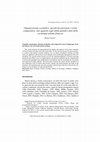
Sociologia urbana e rurale, 2017
This article proposes an unprecedented description and analysis of the main evolutions of French ... more This article proposes an unprecedented description and analysis of the main evolutions of French urban sociology from 2001 until today. Its first section presents the many academic contexts (universities, research institutes, etc.) in which sociologists working on urban issues are employed, and the most recent changes in the institutional organization of the sub-discipline. The second section focuses on how the internationalization of French sociology during the past fifteen years, its fragmentation into thematic subfields and the multiplication of theoretical paradigms have furthered the consolidation and the normalization of an urban and regional sociology subfield. The third section analyzes the causes and the modalities of the comparative turn of French urban studies. Finally, the fourth presents the limits to the dynamics of homogenization and some peculiar research topics that have favored the subsistence or the emergence of national specificities.
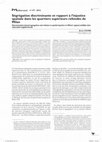
Méditerranée, 2016
Abstract – This article draws from eldwork conducted in 2004-2008 in San Felice and Milano 2, us... more Abstract – This article draws from eldwork conducted in 2004-2008 in San Felice and Milano 2, using among other methods ethnographic observation and 34 in-depth interviews. It analyzes how discrimination- based segregation takes place in the refounded neighborhoods of Milan’s metropolis, and the relation of their inhabitants to spatial justice. The rst section of the article shows in particular how the refusal of diversity by the residents was based on xenophobic, Islamophobic and Romaphobic prejudices and obsidional representations (more or less strong depending of the period). The second section focuses on the effects – over the sense of justice of the inhabitants – of a national public sphere where urban segregation is never addressed or even framed as a problem.
Résumé – À partir d’une enquête de terrain, combinant notamment observation participante et 34 entretiens approfondis, réalisée entre 2004 et 2008 dans les quartiers de San Felice et Milano 2, cet article analyse les ressorts de la ségrégation discriminante et le rapport à la justice spatiale dans les espaces refondés de la métropole milanaise. La première partie montre notamment comment le refus de la mixité s’appuyait chez les habitants de ces quartiers sur des préjugés et des sentiments obsidionaux xénophobes, islamophobes et tsiganophobes (plus ou moins prononcés selon la période considérée). La seconde partie s’intéresse quant à elle aux effets, sur le sens du juste des habitants, d’un espace public national dans lequel la ségrégation urbaine n’est pas une question débattue.
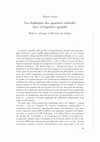
En s’appuyant sur cinquante-cinq entretiens approfondis réalisés entre 2004 et 2008 auprès d’habi... more En s’appuyant sur cinquante-cinq entretiens approfondis réalisés entre 2004 et 2008 auprès d’habitant-e-s des espaces refondés de Courbevoie et Levallois-Perret (Hauts-de-Seine), on analyse ici le sens de la justice spatiale de ces derniers, ainsi que les arrangements et les compromis qu’ils mettent en avant lorsque leurs choix résidentiels et leur rapport à la mixité sont soumis à la critique. Portant sur une fraction des classes (moyennes-)supérieures ayant choisi d’habiter dans de nouveaux quartiers particulièrement homogènes socialement, cet article propose ainsi un aperçu inédit des justifications, tentatives de justification et refus de justification d’une population participant au maintien et à l’aggravation de la ségrégation urbaine.
Drawing from 55 in-depth interviews with residents of the new-build neighborhoods of Courbevoie and Levallois-Perret (Hauts-de-Seine) carried out in 2004-2008, we analyze their sense of spatial justice, as well as the arrangements and compromises they display when their residential choices and their attitude towards local integration are challenged. By focusing on a segment of the upper-middle class that chose to live in new, remarkably socially homogeneous neighborhoods this article offers an unprecedented insight into the justifications, attempted justifications, and refusals to justify themselves of a population playing an active role in the upkeep and increase of urban segregation.
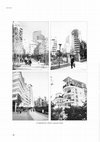
Cet article s’appuie sur une enquête de terrain réalisée dans trois nouveaux quartiers de Courbev... more Cet article s’appuie sur une enquête de terrain réalisée dans trois nouveaux quartiers de Courbevoie et Levallois-Perret (Hauts de-Seine), situés à proximité du centre d’affaires de La Défense, et au sein desquels les résidents cadres et ingénieurs d’entreprise sont fortement surreprésentés. Il s’agit d’espaces issus du processus de refondation (new-build gentrification) qui contribue régulièrement à l’élargissement de l’axe historique des beaux quartiers. On analyse successivement les ressorts et motivations des choix résidentiels de leurs habitants, la faible sociabilité locale liée à un entre-soi particulier, et enfin le rôle central joué par le marquage de frontières symboliques socioéconomiques (internes aux classes supérieures) dans les dynamiques d’agrégation. Cette dernière apparaît par ailleurs comme suivant une logique largement distincte de celle dont relève l’évitement des classes populaires (altérisées et stigmatisées).
This article is based on fieldwork conducted in three new neighborhoods of Courbevoie and Levallois-Perret (Hauts-de-Seine, west of Paris), which are located near the business district of La Défense, and where corporate professionals and managers are overrepresented among the residents. These areas have been transformed by the process of new-build gentrification that regularly contributes to enlarging the historic western axis of Paris’ upper-class neighborhoods. The paper analyzes successively the causes and motivations of the inhabitants’ residential choices, the weak local sociability associated with this specific type of urban self-segregation, and the key role played by the drawing of socioeconomic symbolic boundaries among the uppermiddle classes. Indeed, homophilic aggregation in the refounded neighborhoods follows a logic largely different and autonomous from the (complementary) one – based on radical alterization and stigmatization – that motivates the avoidance of the working class.

À travers une approche articulant plusieurs comparaisons — interlocale, internationale et interco... more À travers une approche articulant plusieurs comparaisons — interlocale, internationale et interconcep-tuelle — cet article identifie, au sein de la mosaïque sociospatiale des grandes métropoles européennes, une configuration d'autoségrégation des classes supérieures et un rapport à la mixité que la recherche avait igno-rés jusqu'ici. Ce mode spécifique de production et d'habitat de la ville est analysé dans des quartiers à forte concentration de cadres, proches des nouveaux centres d'affaires, et est qualifié de refondation. En effet, il ne peut être ramené à la préservation d'un entre-soi bourgeois traditionnel, à de la gentrification progressive ou à de la sécession périurbaine ; ni à une combinaison quelconque des trois. Il s'agit au contraire d'un phénomène original, dont les traits constitutifs ainsi que les déclinaisons à Paris et à Milan ne peuvent être pleinement appréhendés que par une démarche compréhensive.
This article combines different forms of comparison: interlocal, international and interconceptual. Within the socio-spatial mosaics of major European cities, it identifies a self-segregation pattern among the upper (middle) classes and a relation to residential integration that have been overlooked until now. This specific way of producing and inhabiting a city is observed in neighborhoods close to the new business centers, and with a high concentration of corporate executives. We call it refoundation. For it cannot be equated with the preservation of traditional bourgeois homogeneity, or with gradual gentrification, or suburban secession; nor even as a combination of the three. On the contrary, it is an original phenomenon, whose distinctive features, and their Paris and Milan versions, can only be fully described through an approach attentive to meaning-making.

Issu d’une enquête de terrain réalisée en 2004-2008 dans les quartiers résidentiels de San Felice... more Issu d’une enquête de terrain réalisée en 2004-2008 dans les quartiers résidentiels de San Felice et Milano 2, cet article contribue à l’analyse différenciée des dynamiques d’auto-ségrégation des classes (moyennes-)supérieures milanaises. Dans une première partie, il décrit la configuration urbaine et l’organisation interne de ces quartiers d’immeubles collectifs de haut standing bâtis durant les années 1970 et issus de vastes opérations immobilières d’arasement, reconstruction, repeuplement et enclosure. Il analyse ensuite les représentations, les univers symboliques, les constructions de sens et les registres justificatifs au travers desquels les résidents développent leur refus de la mixité – dessinant ainsi des spécificités italiennes quant à l’articulation entre la hiérarchie sociale et son inscription territoriale.
Drawing from fieldwork conducted in 2004-2008 in the residential neighborhoods of San Felice and Milano 2, this article contributes to a differentiated analysis of the Milanese upper-middle classes’ self-segregation dynamics. Its first section describes the urban configuration and the internal organization of these complexes of exclusive collective buildings erected during the 1970s through large-scale real-estate operations of leveling, reconstruction, repopulation and enclosure. It then analyzes the representations, meaning-making, and registers of justification through which residents articulate their preference for local class homogeneity – highlighting some Italian specificities concerning the relation between social hierarchy and its territorial dimension.










Uploads
Book by Bruno Cousin
Edited books by Bruno Cousin
Face à l’urbanisation croissante de la planète et à la mondialisation qui donnent parfois l’impression d’une homogénéité globale, la comparaison internationale entre villes est devenue un enjeu majeur. Nombre d’organisations publiques et privées classent ainsi les métropoles selon des critères standardisés. Dans le champ académique, la circulation transnationale et les injonctions à l’internationalisation des recherches nourrissent les démarches comparatistes. Mais pourquoi et comment comparer ? Quels sont les avantages, les difficultés, les limites et les pièges de la comparaison ?
Cet ouvrage réunit une vingtaine de chercheurs en sociologie urbaine, qui pratiquent dans leurs travaux la comparaison internationale. Leurs contributions illustrent en quoi, et à quelles conditions, la comparaison peut permettre de mieux analyser les structures socio-spatiales, les processus, les normes et les catégories de pensée. Elles montrent aussi, au-delà de l’approche monographique souvent adoptée dans l’étude des villes, ou en complément de celle-ci, comment différentes façons de comparer permettent de monter en généralité et de développer l’inventivité théorique.
This edited collection examines the realities of the last remnants of the European colonial empires in the Caribbean, namely the British, Dutch and French overseas territories.
Although known and perhaps infamous for their role as high-end tourist destinations and financial centres, these small jurisdictions are complex and multifaceted places. While this volume considers their role as financial centres, it does so from alternative and original perspectives by examining how the sector shapes the internal dynamics of these Caribbean societies, and how it is itself shaped by global trends. A range of contributions is included that highlight other key issues. Political relations between the territories and their metropolitan centres and with the European Union are the focus of several chapters, highlighting the stresses and strains, and in many cases the unfulfilled expectations of devolved governance. Further chapters describe the economic instability and factors of political conflict faced by some of these societies and the available options to address them. Finally, several chapters reflect more specifically on the territories’ internal social and ethnic dynamics, and the hierarchies and inequalities that result.
Bringing together a variety of different disciplinary perspectives, from political science to sociology, and from anthropology to geography, this book will be of great interest to any academic or student who wishes to see how an often overlooked part of the world is actually a key site of socio-economic transformation and a crucial nexus in global affairs.
Edited special issues by Bruno Cousin
Peer-reviewed articles by Bruno Cousin
Résumé – À partir d’une enquête de terrain, combinant notamment observation participante et 34 entretiens approfondis, réalisée entre 2004 et 2008 dans les quartiers de San Felice et Milano 2, cet article analyse les ressorts de la ségrégation discriminante et le rapport à la justice spatiale dans les espaces refondés de la métropole milanaise. La première partie montre notamment comment le refus de la mixité s’appuyait chez les habitants de ces quartiers sur des préjugés et des sentiments obsidionaux xénophobes, islamophobes et tsiganophobes (plus ou moins prononcés selon la période considérée). La seconde partie s’intéresse quant à elle aux effets, sur le sens du juste des habitants, d’un espace public national dans lequel la ségrégation urbaine n’est pas une question débattue.
Drawing from 55 in-depth interviews with residents of the new-build neighborhoods of Courbevoie and Levallois-Perret (Hauts-de-Seine) carried out in 2004-2008, we analyze their sense of spatial justice, as well as the arrangements and compromises they display when their residential choices and their attitude towards local integration are challenged. By focusing on a segment of the upper-middle class that chose to live in new, remarkably socially homogeneous neighborhoods this article offers an unprecedented insight into the justifications, attempted justifications, and refusals to justify themselves of a population playing an active role in the upkeep and increase of urban segregation.
This article is based on fieldwork conducted in three new neighborhoods of Courbevoie and Levallois-Perret (Hauts-de-Seine, west of Paris), which are located near the business district of La Défense, and where corporate professionals and managers are overrepresented among the residents. These areas have been transformed by the process of new-build gentrification that regularly contributes to enlarging the historic western axis of Paris’ upper-class neighborhoods. The paper analyzes successively the causes and motivations of the inhabitants’ residential choices, the weak local sociability associated with this specific type of urban self-segregation, and the key role played by the drawing of socioeconomic symbolic boundaries among the uppermiddle classes. Indeed, homophilic aggregation in the refounded neighborhoods follows a logic largely different and autonomous from the (complementary) one – based on radical alterization and stigmatization – that motivates the avoidance of the working class.
This article combines different forms of comparison: interlocal, international and interconceptual. Within the socio-spatial mosaics of major European cities, it identifies a self-segregation pattern among the upper (middle) classes and a relation to residential integration that have been overlooked until now. This specific way of producing and inhabiting a city is observed in neighborhoods close to the new business centers, and with a high concentration of corporate executives. We call it refoundation. For it cannot be equated with the preservation of traditional bourgeois homogeneity, or with gradual gentrification, or suburban secession; nor even as a combination of the three. On the contrary, it is an original phenomenon, whose distinctive features, and their Paris and Milan versions, can only be fully described through an approach attentive to meaning-making.
Drawing from fieldwork conducted in 2004-2008 in the residential neighborhoods of San Felice and Milano 2, this article contributes to a differentiated analysis of the Milanese upper-middle classes’ self-segregation dynamics. Its first section describes the urban configuration and the internal organization of these complexes of exclusive collective buildings erected during the 1970s through large-scale real-estate operations of leveling, reconstruction, repopulation and enclosure. It then analyzes the representations, meaning-making, and registers of justification through which residents articulate their preference for local class homogeneity – highlighting some Italian specificities concerning the relation between social hierarchy and its territorial dimension.
Face à l’urbanisation croissante de la planète et à la mondialisation qui donnent parfois l’impression d’une homogénéité globale, la comparaison internationale entre villes est devenue un enjeu majeur. Nombre d’organisations publiques et privées classent ainsi les métropoles selon des critères standardisés. Dans le champ académique, la circulation transnationale et les injonctions à l’internationalisation des recherches nourrissent les démarches comparatistes. Mais pourquoi et comment comparer ? Quels sont les avantages, les difficultés, les limites et les pièges de la comparaison ?
Cet ouvrage réunit une vingtaine de chercheurs en sociologie urbaine, qui pratiquent dans leurs travaux la comparaison internationale. Leurs contributions illustrent en quoi, et à quelles conditions, la comparaison peut permettre de mieux analyser les structures socio-spatiales, les processus, les normes et les catégories de pensée. Elles montrent aussi, au-delà de l’approche monographique souvent adoptée dans l’étude des villes, ou en complément de celle-ci, comment différentes façons de comparer permettent de monter en généralité et de développer l’inventivité théorique.
This edited collection examines the realities of the last remnants of the European colonial empires in the Caribbean, namely the British, Dutch and French overseas territories.
Although known and perhaps infamous for their role as high-end tourist destinations and financial centres, these small jurisdictions are complex and multifaceted places. While this volume considers their role as financial centres, it does so from alternative and original perspectives by examining how the sector shapes the internal dynamics of these Caribbean societies, and how it is itself shaped by global trends. A range of contributions is included that highlight other key issues. Political relations between the territories and their metropolitan centres and with the European Union are the focus of several chapters, highlighting the stresses and strains, and in many cases the unfulfilled expectations of devolved governance. Further chapters describe the economic instability and factors of political conflict faced by some of these societies and the available options to address them. Finally, several chapters reflect more specifically on the territories’ internal social and ethnic dynamics, and the hierarchies and inequalities that result.
Bringing together a variety of different disciplinary perspectives, from political science to sociology, and from anthropology to geography, this book will be of great interest to any academic or student who wishes to see how an often overlooked part of the world is actually a key site of socio-economic transformation and a crucial nexus in global affairs.
Résumé – À partir d’une enquête de terrain, combinant notamment observation participante et 34 entretiens approfondis, réalisée entre 2004 et 2008 dans les quartiers de San Felice et Milano 2, cet article analyse les ressorts de la ségrégation discriminante et le rapport à la justice spatiale dans les espaces refondés de la métropole milanaise. La première partie montre notamment comment le refus de la mixité s’appuyait chez les habitants de ces quartiers sur des préjugés et des sentiments obsidionaux xénophobes, islamophobes et tsiganophobes (plus ou moins prononcés selon la période considérée). La seconde partie s’intéresse quant à elle aux effets, sur le sens du juste des habitants, d’un espace public national dans lequel la ségrégation urbaine n’est pas une question débattue.
Drawing from 55 in-depth interviews with residents of the new-build neighborhoods of Courbevoie and Levallois-Perret (Hauts-de-Seine) carried out in 2004-2008, we analyze their sense of spatial justice, as well as the arrangements and compromises they display when their residential choices and their attitude towards local integration are challenged. By focusing on a segment of the upper-middle class that chose to live in new, remarkably socially homogeneous neighborhoods this article offers an unprecedented insight into the justifications, attempted justifications, and refusals to justify themselves of a population playing an active role in the upkeep and increase of urban segregation.
This article is based on fieldwork conducted in three new neighborhoods of Courbevoie and Levallois-Perret (Hauts-de-Seine, west of Paris), which are located near the business district of La Défense, and where corporate professionals and managers are overrepresented among the residents. These areas have been transformed by the process of new-build gentrification that regularly contributes to enlarging the historic western axis of Paris’ upper-class neighborhoods. The paper analyzes successively the causes and motivations of the inhabitants’ residential choices, the weak local sociability associated with this specific type of urban self-segregation, and the key role played by the drawing of socioeconomic symbolic boundaries among the uppermiddle classes. Indeed, homophilic aggregation in the refounded neighborhoods follows a logic largely different and autonomous from the (complementary) one – based on radical alterization and stigmatization – that motivates the avoidance of the working class.
This article combines different forms of comparison: interlocal, international and interconceptual. Within the socio-spatial mosaics of major European cities, it identifies a self-segregation pattern among the upper (middle) classes and a relation to residential integration that have been overlooked until now. This specific way of producing and inhabiting a city is observed in neighborhoods close to the new business centers, and with a high concentration of corporate executives. We call it refoundation. For it cannot be equated with the preservation of traditional bourgeois homogeneity, or with gradual gentrification, or suburban secession; nor even as a combination of the three. On the contrary, it is an original phenomenon, whose distinctive features, and their Paris and Milan versions, can only be fully described through an approach attentive to meaning-making.
Drawing from fieldwork conducted in 2004-2008 in the residential neighborhoods of San Felice and Milano 2, this article contributes to a differentiated analysis of the Milanese upper-middle classes’ self-segregation dynamics. Its first section describes the urban configuration and the internal organization of these complexes of exclusive collective buildings erected during the 1970s through large-scale real-estate operations of leveling, reconstruction, repopulation and enclosure. It then analyzes the representations, meaning-making, and registers of justification through which residents articulate their preference for local class homogeneity – highlighting some Italian specificities concerning the relation between social hierarchy and its territorial dimension.
This article analyzes the genesis of the first Italian “refounded neighborhoods” during the 1970s. Milano San Felice and Milano 2, in the municipality of Segrate, represent two of the main exceptions to the centuries-old centrality of the upper(-middle) classes in the Milanese metropolis. They were produced by large-scale operations of destruction, rebuilding, repopulating and enclosure. More specifically, we address the strategies of innovation, real estate development, city marketing and reinvention of the local memory that contributed to making these neighborhoods a legitimate and attractive residential choice for many wealthy Milanese. The role of Silvio Berlusconi was decisive in this process.